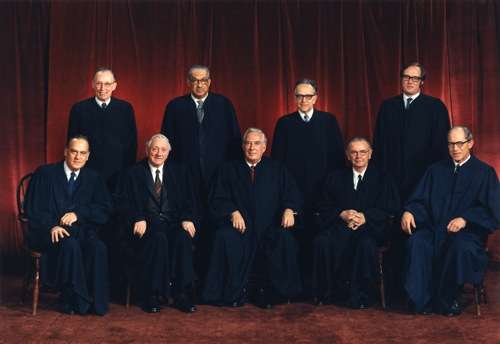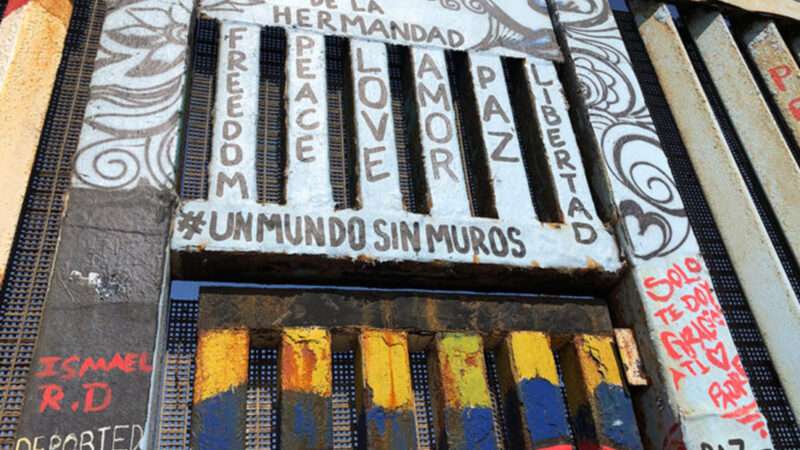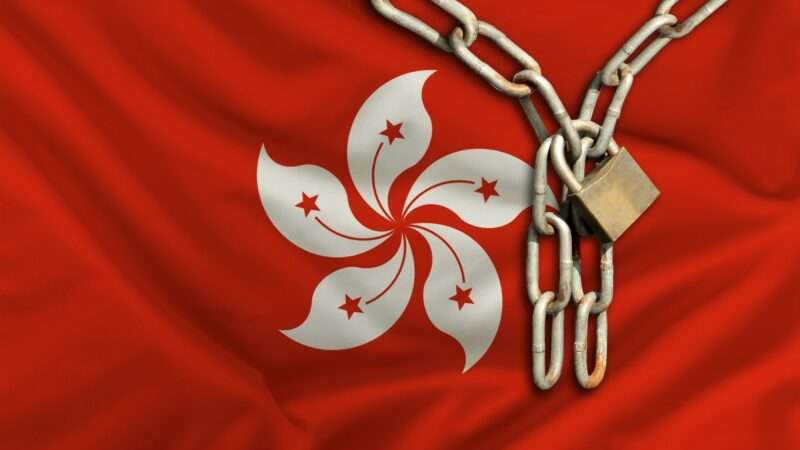1/7/1972: Justices Lewis F. Powell and William H. Rehnquist take oaths.

The post Today in Supreme Court History: January 7, 1972 appeared first on Reason.com.
from Latest – Reason.com https://ift.tt/3t1Jzsd
via IFTTT
another site
1/7/1972: Justices Lewis F. Powell and William H. Rehnquist take oaths.

The post Today in Supreme Court History: January 7, 1972 appeared first on Reason.com.
from Latest – Reason.com https://ift.tt/3t1Jzsd
via IFTTT

Succession, HBO’s biting satire of corporate power struggles at a family-run conservative media conglomerate, could have ended up just a simple parody of the Fox News empire—think Veep, but for the Murdochs. The show follows the trials and travails of the Roy family, led by the swaggering, profane, imperious Logan Roy, who is on his way out and looking for a successor. The primary candidates are his three children, Roman, Shiv, and Kendall, all supported by a rotating cast of high-level functionaries, some of whom might themselves be in line for the throne.
But the show is less interested in mocking the conservative politics of its fictionalized Fox News, which it treats largely as a straightforward business proposition, than in exposing the character flaws of well-paid, well-off coastal elites living lives of pathetic and miserable luxury that they’re intent on preserving at all cost.
The Roy children are variously unserious and un-self-aware: Roman is a weasley suck-up; Shiv is a vain and shallow left-leaning apparatchik; Kendall is a weak-willed, try-hard former drug addict. A fourth, Connor, is a bumbling trust-fund loser with obviously hopeless political ambitions.
Most of their handlers aren’t much better. Although they are marginally more competent than the Roy children, their energy is mostly expended on avoiding blame and responsibility. No one wants to do anything for which they might be held accountable.
Thus, Succession is not so much the story of a powerful right-wing news operation as it is a spoof of America’s self-obsessed, self-dealing elites, in which a brash and abusive (yet ambitious and successful) patriarch finds himself handing the reins to a feckless younger generation that has no real goals beyond avoiding risk.
The post <em>Succession</em> appeared first on Reason.com.
from Latest – Reason.com https://ift.tt/3q1NdAk
via IFTTT

Succession, HBO’s biting satire of corporate power struggles at a family-run conservative media conglomerate, could have ended up just a simple parody of the Fox News empire—think Veep, but for the Murdochs. The show follows the trials and travails of the Roy family, led by the swaggering, profane, imperious Logan Roy, who is on his way out and looking for a successor. The primary candidates are his three children, Roman, Shiv, and Kendall, all supported by a rotating cast of high-level functionaries, some of whom might themselves be in line for the throne.
But the show is less interested in mocking the conservative politics of its fictionalized Fox News, which it treats largely as a straightforward business proposition, than in exposing the character flaws of well-paid, well-off coastal elites living lives of pathetic and miserable luxury that they’re intent on preserving at all cost.
The Roy children are variously unserious and un-self-aware: Roman is a weasley suck-up; Shiv is a vain and shallow left-leaning apparatchik; Kendall is a weak-willed, try-hard former drug addict. A fourth, Connor, is a bumbling trust-fund loser with obviously hopeless political ambitions.
Most of their handlers aren’t much better. Although they are marginally more competent than the Roy children, their energy is mostly expended on avoiding blame and responsibility. No one wants to do anything for which they might be held accountable.
Thus, Succession is not so much the story of a powerful right-wing news operation as it is a spoof of America’s self-obsessed, self-dealing elites, in which a brash and abusive (yet ambitious and successful) patriarch finds himself handing the reins to a feckless younger generation that has no real goals beyond avoiding risk.
The post <em>Succession</em> appeared first on Reason.com.
from Latest – Reason.com https://ift.tt/3q1NdAk
via IFTTT
Assange Has Spent 1,000 Days In The “Harshest Prison In UK”: WikiLeaks
Authored by Brett Wilkins via Common Dreams,
Press freedom campaigners on Wednesday marked Julian Assange’s 1,000th day of imprisonment in London’s Belmarsh Prison with renewed demands for the WikiLeaks publisher’s freedom ahead of his looming potential extradition to the United States.
Assange’s partner Stella Morris said in a statement: “It will be 1,000 days this Wednesday that Julian Assange has spent in the harshest prison in the U.K. His young children, ages two and four, have no memory of their father outside the highest security prison of the U.K.”
“The future of journalism is at stake – it will not stop with Julian Assange” #FreeAssangeNOW pic.twitter.com/CZxF6uTyul
— WikiLeaks (@wikileaks) January 5, 2022
“Journalism is not a crime,” the Assange Defense Committee tweeted. “#FreeAssange. #DropTheCharges.”
The likelihood of Assange’s extradition to the United States—where he faces charges of violating the Espionage Act that, if he is convicted, could result in a more than 170-year prison sentence—increased last month after the US won an appeal in the U.K. High Court.
Assange can still appeal to the country’s Supreme Court, but there is no guarantee it will consider his case.
Morris and other advocates have previously drawn attention to conditions at Belmarsh, Britain’s first supermax prison, where violence, prisoner self-harm, and Covid-19 are rampant.
Every serious press freedom organization in the world is calling for Assange’s release, and yet the government absolutely refuses to comment—because they know nothing they say can justify such a clear act of political repression. https://t.co/fWOMoQxt0M
— Edward Snowden (@Snowden) January 5, 2022
Assange’s numerous maladies—Morris said he suffered a mini-stroke in October, and he also has heart and respiratory ailments—place the 50-year-old at elevated risk of potentially deadly Covid-19 complications, health experts say.
Tyler Durden
Fri, 01/07/2022 – 06:30
via ZeroHedge News https://ift.tt/3qY1KMB Tyler Durden

“The Wall/El Muro,” a new exhibit at the National Building Museum in Washington, D.C., is a studiously nonideological exploration of border barriers. A placard invites attendees to challenge each other’s views, suggesting the goal is to spark a conversation with a presentation of facts, not to push a narrative.
Pointing to famous walls in history, from the Great Wall of China to the Berlin Wall, the exhibit acknowledges that the idea of borders is ancient. With its timeline of U.S. immigration policy, it’s clear that fear of foreigners is too. Long before Donald Trump rose to the presidency on a platform of building a wall on the Southern border, large sums of money were appropriated for escalating attempts to block people from crossing into the United States.
You also learn that the border crackdown has trapped would-be migrant workers in a permanently undocumented state and led to a spike in the number of deaths during attempted crossings.
What a better policy might look like is for you to decide. The exhibit shows that debates over the meaning and management of national borders will stretch into the future as well as the past.
The post The Wall/El Muro appeared first on Reason.com.
from Latest – Reason.com https://ift.tt/3F3HvCp
via IFTTT

“The Wall/El Muro,” a new exhibit at the National Building Museum in Washington, D.C., is a studiously nonideological exploration of border barriers. A placard invites attendees to challenge each other’s views, suggesting the goal is to spark a conversation with a presentation of facts, not to push a narrative.
Pointing to famous walls in history, from the Great Wall of China to the Berlin Wall, the exhibit acknowledges that the idea of borders is ancient. With its timeline of U.S. immigration policy, it’s clear that fear of foreigners is too. Long before Donald Trump rose to the presidency on a platform of building a wall on the Southern border, large sums of money were appropriated for escalating attempts to block people from crossing into the United States.
You also learn that the border crackdown has trapped would-be migrant workers in a permanently undocumented state and led to a spike in the number of deaths during attempted crossings.
What a better policy might look like is for you to decide. The exhibit shows that debates over the meaning and management of national borders will stretch into the future as well as the past.
The post The Wall/El Muro appeared first on Reason.com.
from Latest – Reason.com https://ift.tt/3F3HvCp
via IFTTT
Omicron Chaos Forces Norwegian Cruise Line To Cancel Sailings Until April
Every cruise ship sailing with passengers in U.S. waters has reports of COVID-19 infections, prompting some cruise ship operators to cancel sails as far out as April.
The number of cruise ships with infections has dramatically increased over recent weeks as the Omicron variant spreads like wildfire throughout the U.S.
The U.S. Centers for Disease Control and Prevention (CDC) has flagged 92 cruise ships with infections this week.
Last week, the CDC raised the COVID-19 Travel Health Notice level for cruise ships from Level 3 to Level 4, the highest level, amid soaring infections. Health officials warned Americans to avoid traveling on cruise ships at all costs.
“The virus that causes COVID-19 spreads easily between people in close quarters on board ships, and the chance of getting COVID-19 on cruise ships is very high, even if you are fully vaccinated and have received a COVID-19 vaccine booster dose,” the agency warned.
Despite all crew and adult passengers required to be fully vaccinated before boarding, Royal Caribbean and Norwegian Cruise Lines announced Wednesday that they would cancel sailings due to breakthrough infections.
Royal Caribbean canceled its Spectrum of the Seas cruise today, and Norwegian Cruise canceled some sailing through April.
Here are Norwegian Cruise’s canceled sailings:
“Due to ongoing travel restrictions, we’ve had to modify a few sailings and unfortunately have had to cancel,” Norwegian Cruise said.
Meanwhile, bigger rival Carnival Corp has yet to cancel any upcoming sailings. Democratic Senator Richard Blumenthal recently called for the industry to “pause or dock their ships” amid the virus outbreak.
What’s ironic is that cruise ships were once lauded as one of the safest vacations due to their strict health policies of only allowing vaxxed adults and their ability to isolate themselves from the rest of the “dangerous” world. Now they’ve become floating COVID-infested cities.
It’s only a matter of time before more sailings are canceled.
Tyler Durden
Fri, 01/07/2022 – 05:45
via ZeroHedge News https://ift.tt/3n4iIrG Tyler Durden
China Secures Foothold In This Strategic Middle East Oil State
Authored by Simon Watkins via OilPrice.com,
Oman continues to expand its cooperation with China as it looks to build out its petrochemical sector
Oman’s options to raise money through conventional bond offerings remain constrained
China already accounts for around 90 percent of Oman’s oil exports and the vast majority of its petrochemicals exports
The recent talks between Oman’s Assistant to the Chief of Staff for Operations and Planning, Brigadier Abdulaziz Abdullah al-Manthri, and the Chief of Staff of Iranian Armed Forces, Major-General Mohammad Bagheri, may mark a new phase in the already deep and broad relationship between Oman and Iran, and in the Sultanate’s drift into the Iran-China axis. “The two countries [Iran and Oman] have conducted several joint naval drills in recent years, within the scope of securing the waterway from the Persian Gulf through to the Gulf of Oman from smuggling and other threats, including terrorism, but these [recent] talks were concerned with expanding that cooperation both in terms of the armed services involved beyond just the navy and the scope of their joint activities beyond anti-smuggling and dealing with terrorist threats,” an Iranian source who works closely the Petroleum Ministry told OilPrice.com last week. The basic catch-22 for Oman that has expedited its move towards the Iran-China power axis is that it lacks the scale of natural resources to generate the financing required to keep its economy ticking over without any further industry but the industry that it is looking to diversify its economy with – petrochemicals – requires a lot of upfront financing before it pays off.
Consequently, with only around five billion barrels of estimated proved oil reserves (barely the 22nd largest in the world) and minimal natural gas reserves – Oman explored many options to bridge this financing gap but its budget problems were dramatically worsened by the Saudi Arabia-instigated Oil Price Wars of 2014-2016 and 2020. Even before the 2020 attempt by Saudi to severely disable the U.S.’s shale oil sector by using exactly the same strategy that had failed in 2014-2016 and had destroyed the budgets of its OPEC brothers as well, as analyzed in-depth in my new book on the global oil markets, Oman had been facing a budget deficit for that year alone of at least 18 percent of GDP and budget deficits averaging at least 15 percent per year over the next five years.
In order to give it time to develop its answer to many of its financial problems – the rollout of the perennially-delayed but potentially game-changing Duqm Refinery Project and its corollary projects of a product export terminal in Duqm Port and Duqm refinery-dedicated crude storage tanks in Ras Markaz – Oman tried several options to raise money. So determined was Oman to keep its fiscal deficit within manageable proportions that not only did it implement measures (including lower expenditure on wages and benefits, subsidies, defense, and capital investment by civil ministries) that reduced expenditure (in 2016 by around 8 percent of GDP) but also moved to rein-in hydrocarbons-related spending as well. In this context, the Sultanate’s Financial Affairs and Energy Resources Council formed a specialized working group to study public spending and the means by which to reduce it. At the same time, it was made clear that the Omani government would apply zero-based budgeting in the ninth five-year plan of approving allocations for development projects only after all feasibility studies and real cost analysis of each of them had been completed. The Council also underlined that it aimed to avoid having any additional requests for funding from developers after any project had been started.
However, Oman’s problems relating to the Duqm Refinery Project became worse in 2016 when the UAE’s International Petroleum Investment Company (IPIC) said that the Duqm project no longer fitted its overall investment strategy, in light of the impending merger at the time of IPIC with the Mubadala Development Company, and withdrew from the project. Although this was followed in November by the signing of a memorandum of understanding between the Oman Oil Company (OOC) and the Kuwait Petroleum Corporation (KPC) for co-operation on the construction of the refinery, OilPrice.com understands that this was not even half of the then-estimated cost of US$6 billion. Given the negative international credit ratings outlook, and ratings downgrades in previous years, Oman’s options to raise money through conventional bond offerings remained constrained, and so did the appetite of international investors to buy into any part-privatization of any of Oman’s state-owned companies, even the once much-fancied Oman Oil Refineries and Petroleum Industries Company’s (ORPIC).
It was at this point that China saw its chance to expand its foothold in Oman, which is a key land and maritime hub in Beijing’s multi-generational power-grab project, ‘One Belt, One Road’ (OBOR). Specifically, at around the same time as IPIC withdrew from the project, the refinery operator – the Duqm Refinery & Petrochemical Industries Company (DRPIC) – in tandem with the OOC, appointed a number of global banks, led by regional heavyweight Credit Agricole, to advise on the optimal methods to obtain the funding for the project. These overtures found particular favor with China, which as part of a broad-based investment into Oman pledged the required funding to cover the completion of the Duqm Refinery. However, it came with the usual Chinese caveats of it being allowed to build massive far-reaching infrastructure projects.
Already accounting for around 90 percent of Oman’s oil exports and the vast majority of its petrochemicals exports, China was quick to leverage this by further pledging US$10 billion immediately for investment into the Duqm Refinery Project’s adjunct oil refinery – just after the implementation of the nuclear deal with Iran at the beginning of 2016. At that point, Oman announced that the budget for the Duqm Refinery Project was being increased from the longstanding figure of US$6 billion to a combined US$18 billion for all elements of the Project. This, Oman’s government announced, would enable downstream production to increase from its current 15 million tonnes to 24 million tonnes by 2030, while the commodity sales volumes would nearly double from 21 million tonnes to 40 million tonnes by the same date.
Although further investment from China was geared towards completing the Duqm Refinery – including the export terminal in Duqm Port and the crude storage tanks of the Ras Markaz Oil Storage Park – Chinese money was also funneled towards the construction and building out of an 11.72 square kilometer industrial park in Duqm in three areas – heavy industrial, light industrial, and mixed-use. This has enabled China to secure deeply strategic areas of land in the geopolitically vital Sultanate vitally important Oman, which has long coastlines along the Gulf of Oman and along the Arabian Sea, away from the extremely politically sensitive Strait of Hormuz. It also offers largely unfettered access to the markets of South Asia, West Asia, and Africa, as well as to those of its neighbors in the Middle East. Following the usual Chinese template of investment, it has also given China the opportunity to populate these areas its own people, from project managers to security personnel.
In line with these developments, the addition of Oman to its Middle East territorial acquisitions means that Beijing can fast-track the transport routes between Iran and Oman. A long-mooted adjunct to China’s direct plans in this context has been the utilization by Iran of Oman’s unused liquefied natural gas (LNG) capacity. This plan, long talked about between Tehran and Muscat, is part of Iran’s plans to become an LNG superpower based on its massive South Pars and North Pars non-associated gas fields. Oman for its part would allow Iran to use 25 percent of the Sultanate’s total 1.5 million tons per year LNG production capacity at the Qalhat plant. This could be done as part of a broader plan to build a 192-kilometer section of 36-inch pipeline running along the bed of the Oman Sea at depths of up to 1,340 meters from Mobarak Mount in Iran’s southern Hormuzgan province to Sohar Port in Oman for gas exports. This, in turn, would re-open the possibilities for further pipeline routes running from Iran to Oman and then into Pakistan and then into China, and the other way around, all under the security protection of China, irrespective of any plans that the U.S. might have in the southern part of the Shia crescent of power in the region, as also analyzed in-depth in my new book.
Tyler Durden
Fri, 01/07/2022 – 05:00
via ZeroHedge News https://ift.tt/3qYKsyT Tyler Durden

Hong Kong police have charged two former editors of a pro-democracy newspaper with sedition. Chung Pui-kuen and Patrick Lam, former editors at Stand News, were denied bail. They face up to two years in prison and a fine of up to 5,000 Hong Kong dollars ($640 U.S.). Police also detained four Stand News board members for questioning.
The post Brickbat: All the News That's Fit to Punish appeared first on Reason.com.
from Latest – Reason.com https://ift.tt/3n5hPyX
via IFTTT
Brussels Airlines Flew 3,000 Empty Flights This Winter, All To Maintain Spots At Major Airports
Investing question: how “ESG” is it for an airline to operate to the tune of 3,000 unnecessary flights, all of which are burning jet fuel, simply to keep take-off and landing rights at major airports?
Because that’s exactly what’s going on with Brussels Airlines, according to news from Belgium’s The Bulletin.
The airline’s parent company, Lufthansa, reportedly operated 18,000 flights over the winter that would have otherwise been cancelled due to lack of passengers, the report says. Brussels Airlines accounted for 3,000 of those flights.
As a result, the Belgian federal government has contacted the European Commission, urging it to change its rules for how airlines secure rights at major airports.
Previously, the rule was that “airlines must operate flights in at least 80% of their scheduled take-off and landing slots”, the report says. Post-Covid, the requirement dropped to 50%, which is still far above the actual number of flights that would meet demand from passengers.
Belgium’s federal mobility minister Georges Gilkinet called the rules “incomprehensible from an economic and ecological point of view” and called for a further reduction of the threshold.
Meanwhile, Lufthansa still plans to cancel 33,000 scheduled flights by the end of March.
Tyler Durden
Fri, 01/07/2022 – 04:15
via ZeroHedge News https://ift.tt/3q4PWJy Tyler Durden